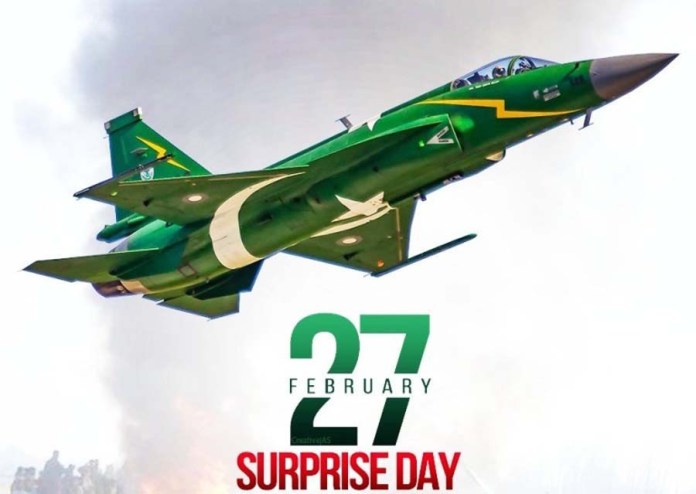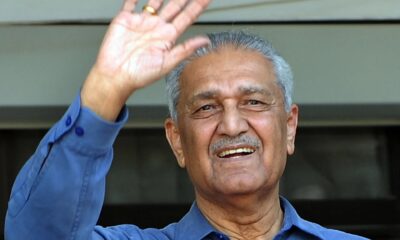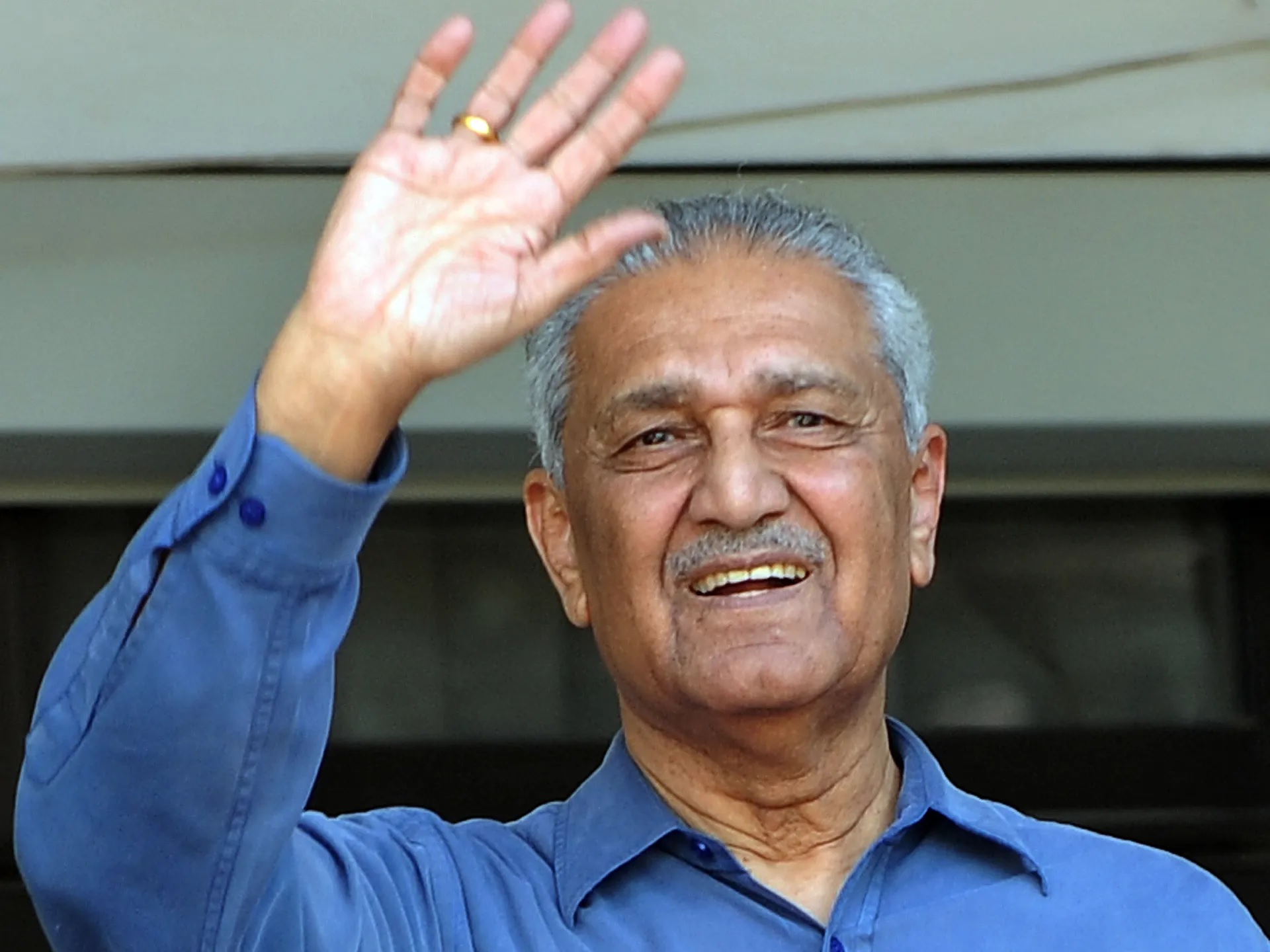Pakistan
Botched Indian “Operation Bandar” – 2 IAF aircraft down, 1 pilot captured
Published
4 years agoon
By
Editor

With two aircraft down, one pilot captured alive – “Operation Bandar” – the Balakot strike – failed to achieve not only its objectives but also exposed to the world the inherent weaknesses of a nuclear-armed Inda.
The botched attempt to strike deep inside Pakistan following a false flag operation at Pulwama on Feb 14, 2019, established the military and technological superiority of the Pakistan Air Force and shattered to pieces the myth of Indian military might.
Operation Bandar
The Indian authorities code-named the attack on Balakot as “Operation Bandar” to minimize the chances of leaking the news. The word “Bandar” was chosen because monkeys enjoy a sacred place in the Hindu religion and this refers to a tale in the religious myths of Hinduism where Hanuman – a deity who shows resemblance to the monkey – secretly entered Lanka and burned it to the ground.
Feb 26, 2019 – Balakot Strike
The Indian Air Force launched an aerial strike near ‘Balakot’ On Feb 26, 2019, targeting a religious seminary that India described as a militant camp, and claimed killing more than 300 terrorists but without sharing any shred of evidence to corroborate the claims.
According to Hindustan Times on February 26, 2019 at 3.45am the then Air Chief BS Dhanoa made a telephone call to National Security Adviser Ajit Doval on a secure fixed-line network and said “Bandar mara gaya” – “The monkey has been killed,” but at the end of the day, they just made a monkey of themselves.
INDIAN AIRCRAFTS INTRUDED FROM MUZAFARABAD SECTOR. FACING TIMELY AND EFFECTIVE RESPONSE FROM PAKISTAN AIR FORCE RELEASED PAYLOAD IN HASTE WHILE ESCAPING WHICH FELL NEAR BALAKOT. NO CASUALTIES OR DAMAGE.
— DG ISPR (@OFFICIALDGISPR) FEBRUARY 26, 2019
Following the strike Prime Minister Imran Khan said “India has committed uncalled-for aggression to which Pakistan shall respond at the time and place of its choosing…Armed Forces and the people of Pakistan to remain prepared for all eventualities.”
The Indian strike struck a hillside, killing one crow and damaging few precious pine trees, an act which prompted Prime Minister Imran Khan to repeatedly say that he was very hurt, as trees were very close to his heart.

Military attache’ and foreign media also later visited the site and also went to the nearby madrassa of local village children, who were lucky enough to escape the Indian recklessness.
India claimed that its air force had managed to kill more than 300 terrorists while Pakistan but several international observers negated the claim as there were no casualties and the bombs had clearly missed the target, which in fact was not a terrorist camp, but an ordinary religious school, for the village children.
“The Pakistanis are bound to react, conventionally and not through a proxy like a militant group,” Rahul Bedi, an analyst at the London-based Jane’s Information Group told the New York Times. “Where they react and when is something that only Pakistanis know.”
The newspaper pointed that in the run-up to Indian elections this spring, and with Mr. Modi facing a fierce re-election fight, voters have demanded that New Delhi respond to the Kashmir attack with force against Pakistan.
“What they hit is speculation for now,” Mr. Bedi said. “This is more political symbolism than anything else. Mr. Modi had to show some demonstrable action on India’s part, ahead of elections.”

Feb 27, 2019
In response, Pakistan Air Force launched a counter-strike on Feb 27, 2019, intended primarily to demonstrate Pakistan’s resolve. The strike was carefully crafted to avoid casualties on the ground.
During the short aerial encounter that followed, PAF shot down two IAF aircraft and captured one of the pilots. The success of the Pakistan Air Force in Operation Swift Retort against a far bigger adversary is now observed as a “Surprise Day” every year.
IN RESPONSE TO PAF STRIKES THIS MORNING AS RELEASED BY MOFA, IAF CROSSED LOC. PAF SHOT DOWN TWO INDIAN AIRCRAFTS INSIDE PAKISTANI AIRSPACE. ONE OF THE AIRCRAFT FELL INSIDE AJ&K WHILE OTHER FELL INSIDE IOK. ONE INDIAN PILOT ARRESTED BY TROOPS ON GROUND WHILE TWO IN THE AREA.
— DG ISPR (@OFFICIALDGISPR) FEBRUARY 27, 2019

Wing Commander Abhinandan – File PhotoIndia claimed that one of its Mig-21s shot down Pakistan’s F-16 aircraft which was also refuted by the influential Foreign Policy magazine based on interviews with the US Department of Defence (DoD) officials who verified that no F-16 was missing from the Pakistani inventory.
According to the magazine, Pakistan invited the US to physically count its F-16 planes after the incident as part of an end-user agreement signed when the foreign military sale was finalized.
Some of the aircraft were not immediately available for inspection due to the conflict, so it took US personnel several weeks to account for all of the jets, one US official said.
But now the count has been completed, and “all aircraft were present and accounted for,” the official said.”
While the Indian so-called surgical strike was being touted by India as a great success and declared as a ‘new norm’, but on the other hand, India’s senior leadership blamed the failure on the non-availability of aircraft like Rafale, which according to them would have changed the outcome of Balakot crisis.
Even the Indian Prime Minister Narendra Modi admitted the failure of his Air Force and while speaking at the India Today event said “Today, all of India is saying that if we had the Rafale, then the result would have been different.”
Pakistan’s response was intended to deter war and establish nuclear deterrence, the success of which could be gauged by the fact that India could not move up the escalation ladder and backed down.
#PAKISTANSTRIKESBACK #PAF UNDERTOOK STRIKES ACROSS LOC FROM PAKISTANI AIRSPACE. SOLE PURPOSE OF THIS ACTION WAS TO DEMONSTRATE OUR RIGHT, WILL AND CAPABILITY FOR SELF DEFENCE. WE DO NOT WISH TO ESCALATE BUT ARE FULLY PREPARED IF FORCED INTO THAT PARADIGM#PAKISTANZINDABAD
— SPOKESPERSON 🇵🇰 MOFA (@FOREIGNOFFICEPK) FEBRUARY 27, 2019
On Feb 27, the military’s media wing said Pakistan Air Force had engaged six targets at the LoC. Maj Gen Ghafoor termed it a conscious decision not to attack any military target and avoid any collateral damage. He said one of the targets initially picked was a military administrative complex, however, the PAF command decided against hitting it.
“As a result of engaging our targets, no human life was affected. Staying within our jurisdiction, six targets were locked. And we carried out the strike,” he said.
He said the objective of the strikes was to show “we have the capacity and the will to respond, but we deliberately avoided the escalation path.”
“Pakistan is not pushing for war. We engaged our targets in open air, we deliberately avoided escalation. We could easily have taken the original targets, but we did not do that,” the DG ISPR said.
Feb 28, 2019
A day later Prime Minister Imran Khan in his address to a joint parliamentary session on Feb 28, 2019, said; “In our desire for peace, I announce that tomorrow, and as a first step to open negotiations, Pakistan will be releasing the Indian Air Force officer in our custody.” His decision was hailed by top world leaders as a great peace gesture.
March 1, 2019
Wing Commander Abhinandan was treated well, in line with the Geneva Conventions, provided new dress and of course the famous cup of tea, on which he had remarked: “Tea was Fantastic“. He was handed over to the Indian authorities on March 1, 2019 at the Wagah border.

Pakistan has credible conventional responses designed to meet different contingencies – known as the policy of ‘Quid Pro Quo Plus.’ This has not only reinforced the credibility of Pakistan’s nuclear deterrence but has also helped restore confidence in conventional deterrence.
After experiencing humiliation at the hands of PAF in Feb 2019, India has gone on yet another arms and ammunition shopping spree, without understanding that it is in fact the man behind the machine and the will that matters.
In Laddakh India again suffered humiliation as China established its superiority and controlled the full spectrum of the conflict. The Chinese had calculated the morale and response capability of the Indian military. India stood embarrassed by a smaller force – Pakistan and was left paralyzed by a larger country- China, all within the span of a year.
However, the best sum up came from DG ISPR Major General Babar Iftikhar who while giving a recap of the Feb 2019 events had said;
“WE GAVE THEM A BLOODY NOSE AND IT IS STILL HURTING”
You may like
-


Unity, Faith, and Discipline: The Cornerstones of Pakistan’s Motto as “Aik Qaum” (One Nation)
-


Aik Qaum: The Fusion of Integrity and Patriotism
-


“AIK QAUM” DECLARATION OF CONCEPTION
-


Dr. Abdul Qadeer Khan: The Real Hero of Pakistan
-


The Chiltan Ibex: A Rare Treasure of Balochistan
-


MANGO HEALTH BENEFITS NUTRITION
Pakistan
Unity, Faith, and Discipline: The Cornerstones of Pakistan’s Motto as “Aik Qaum” (One Nation)
Published
3 weeks agoon
May 28, 2025By
EDITOR
The guiding motto of Pakistan, “Unity, Faith, and Discipline,” holds profound significance in shaping the national identity of Pakistanis as “Aik Qaum” (One Nation). These three words, coined by the country’s founding father, Quaid-e-Azam Muhammad Ali Jinnah, form the bedrock of the national ethos. They represent the essential pillars upon which Pakistan was built and must continue to stand in pursuit of progress, solidarity, and global stature.
This motto is not just a political slogan or a patriotic catchphrase; it is an enduring call for the people of Pakistan to unite under a common banner of national purpose, to have faith in their capabilities, and to uphold the discipline needed for personal and national success. In this detailed article, we will explore the deeper meanings and implications of unity, faith, and discipline, and how these principles guide the vision of Pakistan as a united and resilient nation.
Unity: The Power of Togetherness
Unity is the first and foremost element of Pakistan’s national motto. It emphasizes the importance of national cohesion and solidarity across the diverse ethnic, linguistic, and religious landscape of Pakistan. As a nation that emerged from the crucible of colonialism and division, Pakistan’s unity has always been central to its survival and growth.
At its core, unity signifies a collective commitment to the country’s well-being, transcending personal or communal differences. Pakistan is home to a wide variety of cultures, languages, and sects, from the Punjabis, Sindhis, Pashtuns, and Baloch to religious minorities such as Christians, Hindus, and Sikhs. The concept of unity calls for embracing this diversity as a source of strength, rather than as a source of division.
Historically, the drive for unity was integral to the Pakistan Movement, which brought together Muslims from different regions of British India to fight for a common homeland. Quaid-e-Azam Muhammad Ali Jinnah recognized that only through unity could the Muslims of the subcontinent secure their political, economic, and social rights. His vision for Pakistan was one where all citizens, regardless of their background, would work together for the common good.
In modern-day Pakistan, unity remains vital for addressing the challenges of sectarianism, regionalism, and external threats. A united Pakistan is better equipped to deal with issues such as poverty, terrorism, and political instability. The concept of unity fosters a sense of belonging and national pride, urging Pakistanis to think of themselves as one people, with one purpose, under one flag.
Faith: Belief in a Higher Cause and in Ourselves
Faith is the second pillar of Pakistan’s motto and is deeply rooted in the spiritual and ideological foundation of the country. Pakistan was established as a homeland for Muslims, and faith in Islam has always been central to its identity. However, faith as a motto goes beyond mere religious belief; it encompasses a broader sense of confidence, trust, and belief in a higher cause, in the potential of the nation, and in the resilience of its people.
For Pakistan, faith is twofold: it represents both religious faith and faith in the nation’s future. Pakistanis draw strength from their spiritual beliefs, finding unity and purpose in the teachings of Islam, which emphasize justice, equality, and community welfare. This religious faith provides a moral compass for both governance and daily life, promoting values such as honesty, compassion, and responsibility.
Faith also refers to belief in Pakistan’s potential. Pakistan has faced numerous challenges since its inception in 1947, from wars and natural disasters to political turmoil and economic crises. Through it all, the faith of its people in the country’s resilience and eventual success has been unwavering. This faith in Pakistan’s ability to rise above adversity and build a better future remains a key motivator for both the government and the citizenry.
Jinnah, in his speeches, often urged Pakistanis to have faith in themselves, in their institutions, and in their destiny. He believed that faith in the country’s foundational principles would ensure its survival and prosperity. In today’s rapidly changing world, this faith is crucial in fostering optimism, innovation, and national pride among Pakistanis.
Discipline: The Key to Progress and Stability
The third and final element of Pakistan’s national motto is discipline, a principle that Jinnah regarded as essential for the development of a strong, stable, and successful nation. Discipline is the cornerstone of order, efficiency, and progress. It demands that citizens and leaders alike act with responsibility, accountability, and foresight.
For Pakistan to achieve its full potential, discipline is required at both the individual and institutional levels. On a personal level, discipline involves hard work, ethical behavior, and adherence to the rule of law. It requires Pakistanis to be diligent in their pursuits, whether in education, work, or civic duties, and to prioritize the common good over personal gain.
On a broader scale, national discipline means the effective functioning of the state, including the proper management of resources, the upholding of justice, and the fair enforcement of laws. A disciplined nation adheres to democratic values, maintains the integrity of its institutions, and operates with transparency and accountability. Discipline ensures that the country can handle crises, avoid corruption, and build a sustainable economy.
Jinnah himself was a model of discipline. His dedication to the cause of Pakistan, his meticulous planning, and his unwavering commitment to the principles of justice and fairness were key factors in the success of the Pakistan Movement. He emphasized that without discipline, a nation could not stand firm, nor could it achieve its desired goals.
Today, Pakistan faces numerous challenges that require discipline in governance, education, healthcare, and defense. The globalized world presents both opportunities and obstacles, and only through disciplined efforts can Pakistan compete on the world stage. Whether in fighting corruption, strengthening institutions, or promoting social cohesion, discipline remains a critical factor in Pakistan’s progress.
The Relevance of “Unity, Faith, and Discipline” in Modern Pakistan
As Pakistan navigates the 21st century, the principles of unity, faith, and discipline are more relevant than ever. These values are not just historical legacies but are guiding principles for Pakistan’s future as a vibrant, resilient, and prosperous nation. In an era of rapid globalization, technological advancement, and shifting political dynamics, these ideals provide a steady framework for national development and collective progress.
- Unity is vital for overcoming internal divisions and presenting a strong, cohesive front on the international stage.
- Faith continues to be a source of strength, providing hope, moral guidance, and belief in the country’s bright future.
- Discipline is crucial for tackling corruption, ensuring effective governance, and building a strong economy capable of competing globally.
In conclusion, “Unity, Faith, and Discipline” remains the heart of the Pakistani identity as “Aik Qaum” (One Nation). It encapsulates the aspirations of a people who, despite facing numerous challenges, remain committed to the vision of a united, just, and prosperous Pakistan. These principles, when embraced and practiced by all Pakistanis, have the power to shape a future that honors the past while paving the way for new achievements on the world stage.
Article
Aik Qaum: The Fusion of Integrity and Patriotism
Published
3 weeks agoon
May 28, 2025By
EDITOR
We keep Integrity closest to our Heart and Patriotism on top of our mind.
Integrity and patriotism are not separate entities; they are intertwined in the soul of Pakistan. The people understand that to be a patriot is to uphold the principles of integrity. Honesty and love for one’s country are two sides of the same coin. Together, these values form the essence of “Aik Qaum.”
The fusion of integrity and patriotism is evident in the everyday lives of Pakistanis. It’s in the farmer toiling the fields, the teacher educating the youth, and the soldier guarding the borders. It’s in the child who dreams of a better Pakistan and the elderly who have seen the nation grow. “Aik Qaum” is the realization that integrity and patriotism are the heart and mind of Pakistan, beating in unison to guide the nation forward.
As we celebrate the spirit of “Aik Qaum,” we honor the values that make Pakistan a unique and resilient nation. Integrity and patriotism serve as our guiding stars, leading us towards a brighter and more prosperous future. In the heart of every Pakistani and at the forefront of their minds, “Aik Qaum” stands as a testament to the strength of a united nation, bound by the principles of integrity and the unyielding love for their homeland.
In Pakistan, “Aik Qaum” is not just a motto; it’s a way of life that embodies the enduring spirit of a proud and united nation.
Pakistan
Dr. Abdul Qadeer Khan: The Real Hero of Pakistan
Published
1 month agoon
May 10, 2025By
EDITOR
Dr. Abdul Qadeer Khan, affectionately known as A.Q. Khan, is widely celebrated as the “Father of Pakistan’s Nuclear Program.” His contributions to science and defense not only elevated Pakistan to a new level of self-reliance but also safeguarded the nation’s sovereignty in a volatile region. For many Pakistanis, Dr. Khan is more than a scientist—he is a national hero whose legacy of patriotism, brilliance, and resilience continues to inspire generations.
Early Life and Education
Dr. Abdul Qadeer Khan was born on April 1, 1936, in Bhopal, India. In the aftermath of the partition in 1947, his family migrated to Pakistan. After completing his early education, Khan pursued higher studies in Europe, earning a degree in metallurgy from the Netherlands and later, a doctorate in metallurgical engineering from Belgium.
His education in Europe allowed him to work with some of the most advanced technology of the time. He gained valuable experience working at a European uranium enrichment facility, where he learned the intricacies of centrifuge technology—a technology that would play a pivotal role in his future efforts to develop Pakistan’s nuclear capabilities.
Contribution to Pakistan’s Nuclear Program
In the early 1970s, following Pakistan’s defeat in the 1971 war and India’s successful nuclear test in 1974, the need for Pakistan to develop its nuclear deterrent became urgent. It was at this crucial juncture that Dr. A.Q. Khan offered his services to the government of Pakistan.
Khan’s return to Pakistan marked the beginning of a transformative era in the country’s defense strategy. He was given charge of the Kahuta Research Laboratories (now called Khan Research Laboratories), where he spearheaded Pakistan’s uranium enrichment efforts. Despite limited resources and immense international pressure, Dr. Khan and his team achieved remarkable success. Under his leadership, Pakistan conducted its first successful nuclear test on May 28, 1998, in response to India’s earlier tests, making it the first Muslim-majority country to possess nuclear weapons.
Safeguarding Pakistan’s Sovereignty
Dr. Khan’s role in the successful development of nuclear technology is widely regarded as a crucial factor in maintaining Pakistan’s security and sovereignty. His work ensured that Pakistan had a credible deterrent against external aggression, particularly in light of the hostile relations with its neighbor, India.
The achievement not only bolstered Pakistan’s standing in the global community but also instilled a sense of pride and security within the nation. For many, Dr. Khan became a symbol of national pride, courage, and determination in the face of adversity.
National Hero and Legacy
Dr. Abdul Qadeer Khan passed away on October 10, 2021, leaving behind a legacy that will forever be etched in the history of Pakistan. His funeral was attended by thousands, including political leaders, military officials, and citizens from all walks of life. He was laid to rest with full state honors, a testament to the nation’s deep respect and gratitude for his services.
Dr. Khan’s work ensured that Pakistan remained secure in an unpredictable geopolitical landscape. His contributions to science and defense transformed the country, empowering it with a nuclear deterrent that still serves as a cornerstone of its defense strategy today.
Dr. Abdul Qadeer Khan will always be remembered as a visionary who dedicated his life to serving Pakistan. His brilliance as a scientist, his unwavering commitment to his country, and his determination to see Pakistan rise as a strong, independent nation make him a true national hero. His legacy is a reminder that through perseverance, knowledge, and love for one’s country, even the most daunting challenges can be overcome. Dr. Abdul Qadeer Khan will forever remain the “Real Hero of Pakistan.”

Unity, Faith, and Discipline: The Cornerstones of Pakistan’s Motto as “Aik Qaum” (One Nation)

Aik Qaum: The Fusion of Integrity and Patriotism









